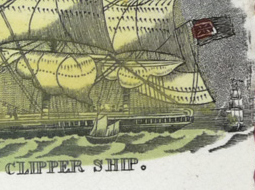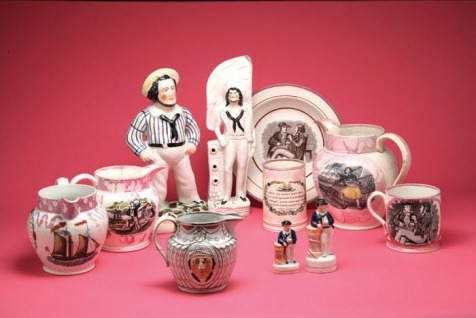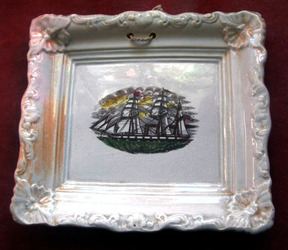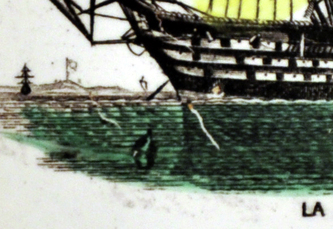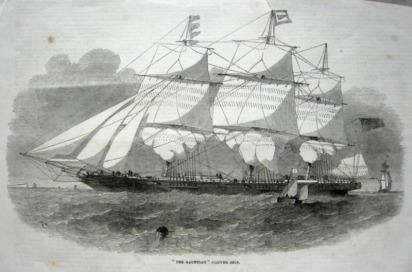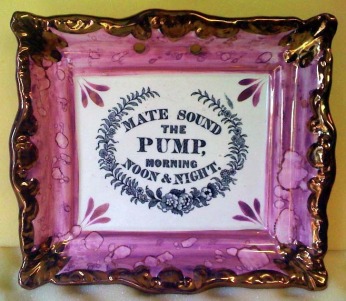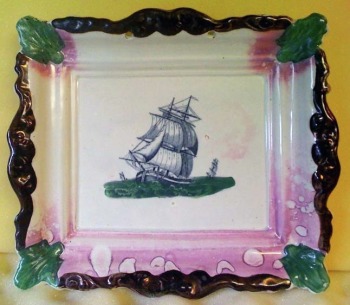|
The Gauntlet Clipper Ship in my July 27 posting, was another fly in the ointment of my attempts to attribute round-cornered plaques (see previous three blog posts). The transfer is most commonly associated with the Garrison pottery, on plaques bearing the impressed mark 'Dixon Co'. Below left is the transfer as it appears on my Garrison plaque, and on the right as it appears on the pink round-cornered plaque. There aren't any obvious flaws common to both transfers that I could find. The missing part of the title on the left plaque arose when the transfer was applied, rather than being a fault on the copper plate (I've seen Garrison plaques with the full title). Also, without having seen the right plaque, it is difficult to balance the contrast in Photoshop, and make images for fair comparison. Interestingly, just as with Bretagne, the transfer sits more obviously on the surface of the round-cornered plaque. Ian Sharp says that on these plaques, the transfer was applied over a glaze. Whereas the Garrison transfer, printed straight onto pottery, appears to have been partially absorbed by the body. Looking at the details though (compare the spacing of the lettering), I think there is little doubt that the transfers come from the same copper plate.
Another factor, I'd not previously considered, is that copper plates were sometimes re-engraved. Appendix III (Baker) states: Because copper is a relatively soft metal the transfer plates were subject to a good deal of wear and required repair. Engraved lines which had become too shallow to hold the required amount of ink were retouched and the plates themselves, which had gradually become curved due to being squeezed between the plate rollers, were flattened out. I wonder whether the diagonal hatching in the clouds to the left of the ship (on the second plaque), might be such an attempt to improve the quality of the image. According to Baker, the Garrison Pottery sold its copper transfer plates when it closed (1865). One such plate was presented to the Sunderland Museum by a member of the Ball family in 1963, engraved with the name 'Dixon, Phillips & Co'. Baker writes 'this copper plate appears to have been passed into the hands of Moore's or Scott's (possibly both) and finally to Ball Brothers'. None of that really helps with our attribution. What we can say with some certainty is that the round-cornered Gauntlet plaque post dates 1865. The first Garrison Gauntlet plaques were likely produced just after 1853 when the ship was launched.
0 Comments
7/25/2010 0 Comments The Pensioner's YarnLa Bretagne was perhaps not the best place to start in making a case for the attribution of orange round-cornered plaques to Scott's of Southwick (see my two previous postings). We know that Moore & Co made orange ship plaques, and we know that transfers from the series of Crimean-era ships – to which La Bretagne belongs – appear on wares stamped Moore & Co. I've racked my brain trying to think of a transfer uniquely associated with Scott, which appears on orange round-cornered plaques. The Pensioner's Yarn appears on typical Scott plaques (see below). It also appears on marked Scott wares like the plate in the photo below, taken by Northeast Auctions. Click here for their description. And it appears on orange plaques. (Thanks to Elinor Penna for the photo below.) I think this greatly strengthens the Scott attribution, or at least enables us to eliminate Moore & Co. I can't think of any transfers, unique to Moore & Co, which appear on these orange-bordered plaques. Or of any Moore wares with The Pensioner's Yarn transfer. Perhaps someone out there will be able to prove me wrong! P.S.It didn't take long to find a flaw in my hypothesis. The transfer on the marked Moore & Co orange plaque (below left) also appears on plaques with rounded corners. I don't remember seeing a Scott version of this transfer. Confusion reigns!
Please read the previous blog post first. Thanks to Ian Sharp for his interesting comments. He supports a Scott attribution for round-cornered orange ship plaques. His first point is who else could have made them? Dixon ceased production in 1865, before the introduction of orange lustre. Moore & Co closed in 1874, which is just within range (we know Moore & Co produced orange plaques – see April 21 posting). The other contender is Ball's Deptford Pottery (Dick Henrywood tentatively suggests this attribution in his article 'Poor Man's Pictures'). Baker writes that in November 1897, at an auction of Scott's effects, copper transfer plates were bought by Ball's Deptford Pottery. Ian says that imperfections in transfers, which appear on Scott marked wares and orange round-cornered plaques support the attribution. There is a transfer imperfection that appears in my three Bretagnes, which shows that they all came from the same copper plate. Take a look at the three pictures below (pink plaque left, orange plaque centre, and plate right). There is a vertical white scratch on the right that cuts through the top row of gun placements (click on the images to enlarge). However, the plates might have been passed between potteries, or Moore & Co plaques sent to Scott for decoration. Perhaps someone out there has a Moore & Co Bretagne with a scratch (please get in touch). Also, as we know Scott sold their plates to Ball's, the orange plaque could have been made in Deptford post 1897.
Looking at these details though, that seems unlikely. As copper plates are used over and over, the engraved lines become weaker. If the orange plaque was made post 1897, when the plate had been around for 42 years, we'd expect the transfer to be fainter. In fact, the details on the orange plaque are far crisper than those on the Scott marked plate. All things taken into consideration, a date of around 1870 and a Scott attribution seem the most likely. 7/24/2010 0 Comments Scott of Southwick ship plaquesLast week I purchased a marked 'SCOTT" plate with 'LA BRETAGNE - 140 GUNS'. Underneath the Scott imprint is the impressed letter 'H". It has provided a great opportunity to compare my two Bretagne plaques with a marked ware. The above plaque, attributed to Scott, is the best quality of the three items. Presumably made circa 1855, the transfer is full of fine detail. The pottery body of the plaque is the creamiest of the three. The enamelling, particularly on the sails, is less shrill - more of an earthy yellow. The second plaque, with an orange border, was made later than the first (perhaps circa 1870). The transfer, although strong, is less fine. This is particularly evident around the rigging. The pottery body is completely different - a dazzling bleached white. The palette of the enamels is also different. The yellow is a more high-octane, acid lemon colour. So what of the marked plate? Interestingly, it shares attributes of both plaques. The pottery body is creamier than the later plaque. However, the colour palette of the enamelling is very close to the orange plaque (closer than the photos suggest – you'll have to take my word for it). The transfer looks to have deteriorated, suggesting a later date. The impressed mark 'Scott' was used from 1841–1897 (Baker), so that doesn't much help us on date.
Few people would dispute the attribution of the older plaque to Scott of Southwick. The colouring of the later plaque is so similar to the plate, it seems probable that it is Scott too. Baker, however, states that 'according to the firm's records, Scott's supplied earthenware to Moore's Wear Pottery and to the Bridge End Pottery, presumably plain for decoration. Scott's also purchased ware from both Maling and Fell of Newcastle.' Moore's pottery, a short walk from Scott's, used similar transfers, and it's possible they decorated each other's plaques, or sent them to the same place for decoration. Until an orange plaque marked Scott turns up (which seems unlikely) it's impossible to attribute this plaque form with complete certainty. 7/23/2010 0 Comments P.S. Gauntlet Clipper Ship7/22/2010 0 Comments Strong bidding at TennantsTwo plaques came up at Tennants Auctioneers today. The first titled 'The Gauntlet Clipper Ship' sold for £280, which with commission etc comes in at around £350. You can see another example of this transfer on the Less common ships page. The second, a smaller plaque titled 'Richard Cobden MP', sold for £450, which with commission is over £550. Proof that even in troubled times, fantastic items hold their value. You can see further examples of Cobden plaques on the Portraits page. Congratulations to their new owner, whoever he or she may be!
7/7/2010 1 Comment MSTP is 6 months oldThis website is 6 months old! Through the marvel of Google Analytics, I can tell you there have been nearly 10,000 page views during 1,705 visits, from 102 British cities, 36 US states and 37 countries worldwide. The average time spent on the site is over 5 minutes. Last night, by coincidence, a Mate Sound the Pump plaque sold on eBay. It attracted 8 bidders, going up to £197 in the first days of the auction. It sold for £225 - not bad for a plaque with a chip - so the honour of MSTP is intact. Though this is the third MSTP plaque to appear on my blog this month, I don't expect to see another for a while. In the whole time I've been collecting, I've seen only 8 or 10. Thanks to everyone for visiting (and returning to) this site, and particularly to Myrna Schkolne, Shauna Gregg, Elinor Penna, Ian Holmes, Norman Lowe and Dick Henrywood, and others who've contributed images, advice or information. I've photographed most of the plaques I know of, so MSTP will now develop at the rate that other collectors contribute to it. Please keep sending photos!
7/1/2010 0 Comments Ship ahoy!Elinor Penna will be putting out a collection of maritime plaques, for sale for the first time, at her Newport, Rhode Island show in August. I've included some photos of the plaques on offer on the 'Exchange' page. If you're interested, please contact Elinor directly: [email protected].
|
AuthorStephen Smith lives in London, and is always happy to hear from other collectors. If you have an interesting collection of plaques, and are based in the UK, he will photograph them for you. Free advice given regarding selling and dispersal of a collection, or to those wishing to start one. Just get in touch... Archives
February 2022
AcknowledgementsThis website is indebted to collectors, dealers and enthusiasts who have shared their knowledge or photos. In particular: Ian Holmes, Stephen Duckworth, Dick Henrywood, Norman Lowe, Keith Lovell, Donald H Ryan, Harold Crowder, Jack and Joyce Cockerill, Myrna Schkolne, Elinor Penna, Ian Sharp, Shauna Gregg at the Sunderland Museum, Keith Bell, Martyn Edgell, and Liz Denton.
|



